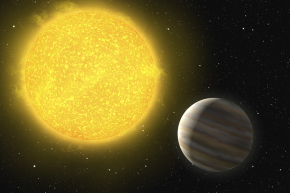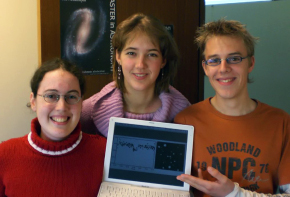The Optical Gravitational Lensing Experiment has thus far rewarded researchers with twelve exoplanets, the most recent announced just today. OGLE’s database is made up primarily of observations taken at the Las Campanas Observatory in Chile, its microlensing methods offering the chance to detect distant worlds that would be difficult if not impossible to study with radial velocity techniques. But because the project is all about parsing the light fluctuations of distant stars, OGLE has also found planets via the transit method, the most recent of them being the work of students at Leiden University in the Netherlands.
OGLE2-TR-L9b is a discovery that points to the wealth of potential data on such worlds that may already exist in our databases. Thus the university’s Ignas Snellen, who supervised the research project, found that the right software could tease a new planet out of OGLE data on some 15,700 stars, observed by the survey over a four year period between 1997 and 2000, even though other goals were in mind. No wonder the professor was surprised:
“The project was actually meant to teach the students how to develop search algorithms. But they did so well that there was time to test their algorithm on a so far unexplored database. At some point they came into my office and showed me this light curve. I was completely taken aback!”

All three students — Meta de Hoon, Remco van der Burg, and Francis Vuijsje — deserve to have their names prominently placed in this story, not only for their contribution to science but for the encouragement their work should give other students now being drawn to the field. Having found the new planet, the team then worked with the European Southern Observatory’s La Silla Observatory (Chile) and the Very Large Telescope at Paranal to confirm the discovery. Spectroscopic analysis from the latter showed not only a planet five times as massive as Jupiter, but also the hottest known star with a planet, a fast-rotating F3 some 1200 degrees Celsius hotter than our own Sun. [Addendum: My mistake re this being the hottest exoplanet star — see the comments below re Fomalhaut and HR 8799].
Image: Artist’s impression of the planet OGLE-TR-L9b. Circling its host star in about 2.5 days, it lies at only three percent of the Earth-Sun distance from its star, making the planet very hot with a bloated roiling atmosphere. The star itself is the hottest star with a planet ever discovered. Credit: ESO/H. Zodet.
OGLE2-TR-L9b circles its primary every 2.5 days at 0.03 AU, a massive, blindingly hot world discovered by a sharp-thinking team with excellent algorithms. And, as we have come to expect with exoplanet discoveries, this one leads to further questions. From the paper:
OGLE2-TR-L9b has a significantly larger radius than expected for a planet of about 4.5 times the mass of Jupiter, even if it is assumed that 0.5% of the incoming stellar luminosity is dissipated at the planet’s center… However, it is not the only planet found to be too large (e.g. CoRoT-exo-2b, TrES-4b, and XO-3b). Several mechanisms have been proposed to explain these ‘bloated’ radii, such as more significant core heating and/or orbital tidal heating…

We are, as I’ve opined before in these pages, in the golden era of exoplanet detection. Not that future technologies won’t yield spectacular results — including planets not so different from our Earth in the habitable zone of their stars — but it’s hard to imagine a better time for a young scientist to be entering the profession than now, when the questions become more multi-faceted with each new discovery and thesis topics abound. Congratulations to the discoverers of OGLE2-TR-L9b!
Image: Undergraduate students Francis Vuijsje, Meta de Hoon, and Remco van der Burg (left to right), whose work uncovered the new extrasolar planet. Credit: Leiden Observatory.
The paper is Snellen et al., “OGLE2-TR-L9: An extrasolar planet transiting a fast-rotating F3 star,” scheduled for publication in Astronomy & Astrophysics and available online.


Hi Paul
The extra-energy source in Hot Jovians is a real puzzler. Louise Riofrio, a rogue Cosmologist, believes that primordial black-holes (PBHs) might exist in abundance, turning up inside planets and making extra-heat. Hot Jupiters might be good PBH traps?
Hottest exoplanet host star?
I guess so, if we discount Fomalhaut, HR 8799, and Beta Pictoris.
Just love the acronym OGLE. :)
Oh, and congratulations to the students.
Thomas writes:
Interesting. What are the numbers on Fomalhaut and HR 8799?
OGLE2-TR-L9: 6933 K
HR 8799: 7430 K
Fomalhaut: 8540 K
(hmm my previous comment evidently looked too much like spam and didn’t even make the moderation queue, so here’s attempt 2)
Well congratulations to the people involved. Not so many congratulations to whoever did the artwork.
Well OGLE2-TR-L9 is an F3 star, while Fomalhaut is an A3 star, which indicates it is going to be hotter. HR 8799 has a weird spectrum thanks to it being a Lambda Bootis-type peculiar star (kA5 hF0 mA5 V; ? Boo), so it’s somewhat difficult to make the call based on spectral type alone. Beta Pic is an A6 star.
OGLE2-TR-L9: 6933 K (source)
HR 8799: 7430 K (source)
Beta Pictoris: 8052 K (source)
Fomalhaut: 8540 K (source)
As far as I can tell, it is still the hottest known exoplanet host star to have a radial velocity or transiting planet detection.
I’ve corrected the original post re my ‘hottest known star with a planet’ statement, clearly a mistake!
Congratulations to the students – great accomplishment so early in life and hope to see more great things from them.
http://ourundiscovereduniverse.com/blog/?p=150
A Metric and Optimisation Scheme for Microlens Planet Searches
Authors: Keith Horne, Colin Snodgrass, Yianni Tsapras
(Submitted on 7 Jan 2009)
Abstract: OGLE III and MOA II are discovering 600-1000 Galactic Bulge microlens events each year. This stretches the resources available for intensive follow-up monitoring of the lightcurves in search of anomalies caused by planets near the lens stars.
We advocate optimizing microlens planet searches by using an automatic prioritization algorithm based on the planet detection zone area probed by each new data point. This optimization scheme takes account of the telescope and detector characteristics, observing overheads, sky conditions, and the time available for observing on each night. The predicted brightness and magnification of each microlens target is estimated by fitting to available data points. The optimisation scheme then yields a decision on which targets to observe and which to skip, and a recommended exposure time for each target, designed to maximize the planet detection capability of the observations.
The optimal strategy maximizes detection of planet anomalies, and must be coupled with rapid data reduction to trigger continuous follow-up of anomalies that are thereby found. A web interface makes the scheme available for use by human or robotic observers at any telescope. We also outline a possible self-organising scheme that may be suitable for coordination of microlens observations by a heterogeneous telescope network.
Comments: 17 pages, 15 figures, MNRAS in press (6 Jan 2009)
Subjects: Astrophysics (astro-ph)
Cite as: arXiv:0901.0846v1 [astro-ph]
Submission history
From: Keith Horne [view email]
[v1] Wed, 7 Jan 2009 16:00:35 GMT (370kb)
http://arxiv.org/abs/0901.0846
Microlensing has apparently found an exoplanet six times the mass of
Jupiter around a star in the Andromeda galaxy, aka Messier 31:
http://www.technologyreview.com/blog/arxiv/23619/